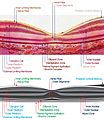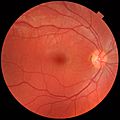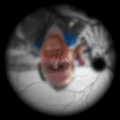Retina facts for kids

Imagine your eye as a camera. The retina is like the film or digital sensor at the back of that camera. It's a super thin layer of special cells that lines the inside of your eye. Its main job is to catch the light that comes into your eye. Then, it sends all that light information to your brain.
Most of the light information from your retina travels through a special cable called the optic nerve. Your brain uses this information to help you understand what you are seeing. Some light information also goes through another path, the retino-hypothalamic tract. This path helps your body adjust its internal clock, called circadian rhythms, to the 24-hour day.
The very center of your retina has a tiny but super important spot called the fovea centralis, or just fovea. This small area is packed with special light-sensing rod cells and cone cells. Even though the fovea is only about 1.5 square millimeters, it's key for clear vision. It makes up only about 1% of your retina, but it sends as much information to your brain's visual cortex as the rest of your retina combined!
Contents
How the Retina Works
The retina is made of many different types of neurons, which are like tiny electrical wires. These neurons work together to turn light into electrical signals. These signals are then sent to your brain.
Light-Sensing Cells
The retina has two main types of light-sensing cells:
- Rod cells: These cells are great at seeing in dim light. They help you see shapes and movement, especially at night or in dark places.
- Cone cells: These cells need brighter light to work. They are responsible for seeing colors and fine details. There are three types of cone cells, each sensitive to different colors: red, green, and blue.
Sending Signals to the Brain
When light hits the rod and cone cells, they create electrical signals. These signals then pass through other layers of cells in the retina. Finally, they reach the ganglion cells. The long tails of these ganglion cells form the optic nerve. This nerve acts like a super-fast internet cable, carrying all the visual information directly to your brain for processing.
The Fovea: Your Sharp Vision Spot
The fovea is a small pit in the center of your retina. It's special because it has the highest concentration of cone cells. This means the fovea is where your sharpest, most detailed color vision happens. When you look directly at something, your eyes automatically try to focus its image onto your fovea. This is why you can read small text or see tiny details.
Retina Health and Care
Keeping your retina healthy is super important for good vision. Just like any other part of your body, the retina can sometimes have problems.
Common Retina Issues
- Retinal detachment: This happens when the retina pulls away from the back of the eye. It can cause blurry vision or even blindness if not treated quickly.
- Diabetic retinopathy: People with diabetes can sometimes have damage to the blood vessels in their retina. This can lead to vision problems.
- Macular degeneration: This condition affects the macula, which includes the fovea. It causes blurry vision in the center of your eyesight, making it hard to read or recognize faces.
Protecting Your Retina
You can help keep your retina healthy by:
- Eating a balanced diet with lots of fruits and vegetables.
- Wearing sunglasses to protect your eyes from harmful UV rays.
- Getting regular eye check-ups.
- Avoiding smoking, as it can harm your eyes.
Images for kids
-
Fundus photograph showing the blood vessels in a normal human retina. Veins are darker and slightly wider than corresponding arteries. The optic disc is at right, and the macula lutea is near the centre.
See also
 In Spanish: Retina para niños
In Spanish: Retina para niños









